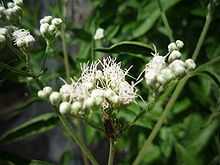Eupatorium serotinum
| Eupatorium serotinum | |
|---|---|
 | |
| Conservation status | |
| Scientific classification | |
| Kingdom: | Plantae |
| (unranked): | Angiosperms |
| (unranked): | Eudicots |
| (unranked): | Asterids |
| Order: | Asterales |
| Family: | Asteraceae |
| Tribe: | Eupatorieae |
| Genus: | Eupatorium |
| Species: | E. serotinum |
| Binomial name | |
| Eupatorium serotinum Michx. | |
Eupatorium serotinum, also known as late boneset or late thoroughwort, is a fall-blooming herbaceous plant native to North America.[2] Like other members of the genus Eupatorium, it is about one to two meters tall and has inflorescences containing a large number of white flowers with disc florets and no ray florets.[3]
It ranges throughout most of the eastern United States, as far south as Mexico (near the Texas border),[4] as far north as the United States–Canadian border, and as far west as Nebraska and Texas.[2]

It grows in open sites (either dry or moist), and can hybridize with Eupatorium perfoliatum[2] and other members of the genus Eupatorium. Unlike wind-pollinated plants in this genus, E. serotinum is pollinated by insects.[5]
References
- ↑ "Eupatorium serotinum". NatureServe Explorer. NatureServe. Retrieved 2010-09-12.
- ↑ 2.0 2.1 2.2 "Eupatorium serotinum". Flora of North America.
- ↑ "Eupatorium". Flora of North America.
- ↑ Schmidt, Gregory J. & Schilling, Edward E. (2000). "Phylogeny and biogeography of Eupatorium (Asteraceae: Eupatorieae) based on nuclear ITS sequence data". American Journal of Botany 87 (5): 716–726. doi:10.2307/2656858. JSTOR 2656858. PMID 10811796.
- ↑ Victoria I. Sullivan, Joseph Neigel and Bomao Miao (May 1991). "Bias in Inheritance of Chloroplast DNA and Mechanisms of Hybridization between Wind- And Insect-Pollinated Eupatorium (Asteraceae)". American Journal of Botany 78 (5): 695–705. doi:10.2307/2445090. JSTOR 2445090.
Further reading
- Bohlmann, F; Zdero, C; King, Rm; Robinson, H (February 1985). "Further Germacranolides from Eupatorium serotinum". Planta medica 51 (1): 76–7. doi:10.1055/s-2007-969404. PMID 17340414.
External links
- Photo from the Ozarks Regional Herbarium of Missouri State University
